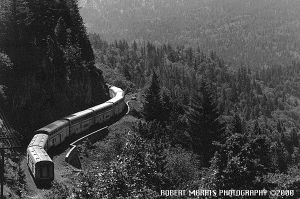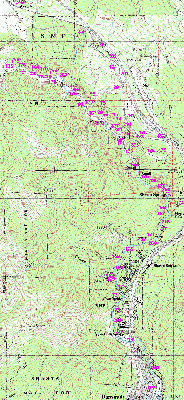Speed Zone 6: Sacramento River Canyon - the climb
Dunsmuir to Azalea
Behind Dunsmuir, the track geometry does not improve. Standard curve radius is still the same: 574 feet. Three things are different, though:
- Before reaching the sidings on top of the hill, there is no possibility for speedup at all.
- Instead, there is a slowdown point: Curve No. 579 "Cantara Loop", with a radius of 410 feet. The defined example trains could go through this loop at 32 mph.
- Ruling grade is 2.2%. While running uphill at 38 mph is an easy task for the defined passenger trains, it means very slow freights and additional helper movements, lowering line capacity within this speed zone.

38 mph would be the speed limit for this climb. Amtrak's "Coast Starlight" is slower.
The only thing to advertise about this piece of track is: Great views. One hundred years ago, this wasn't just great, but a major commercial advantage. Southern Pacific transported lots of tourists to the Sacramento River Canyon, and two special stations were located between Dunsmuir and Azalea: Shasta Retreat and Shasta Springs. Shasta Springs, accessible only by railroad, is gone. Shasta Retreat does not have a station today.

In comparison to the Interstate 5, the train looses lots of time in this part of the route.
"Three hours and a quarter" from Sacramento to Dunsmuir would be a good offer for tourists again. Expecting a considerable number of customers is realistic. But large scale railroad-based tourism, as in the grand history of this line, will never return.